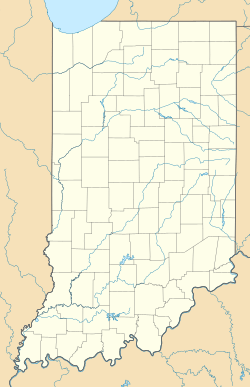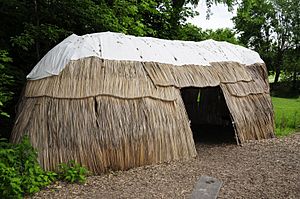Conner Prairie facts for kids
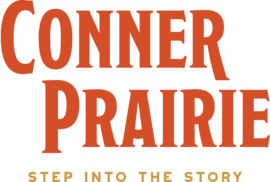 |
|
| Established | 1934 |
|---|---|
| Location | East bank of White River, Hamilton County, Indiana |
| Type | Living history museum |
| Visitors | 414,342 (2019) |
|
William Conner House
|
|
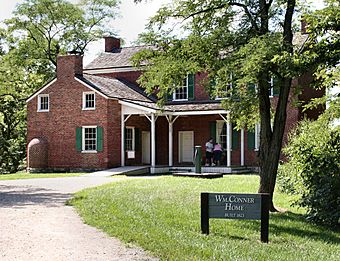
William Conner House
|
|
| Location | 13400 Allisonville Road Fishers, Indiana |
| Built | 1823 |
| Architectural style | Federal |
| NRHP reference No. | 80000038 |
| Added to NRHP | February 8, 1980 |
Conner Prairie is a fun living history museum located in Fishers, Indiana. It helps people learn about life in the 1800s along the White River. The museum also protects the old home of William Conner, which is listed on the National Register of Historic Places.
Conner Prairie hosts many cool events and programs. These include outdoor concerts by the Indianapolis Symphony Orchestra and exciting summer camps.
Contents
Exploring Conner Prairie's Past
How Conner Prairie Began
The land and the William Conner house were bought by Eli Lilly in 1933 or 1934. He was a leader in the medicine business. Lilly wanted to help people connect with history in a way that books couldn't. He fixed up the house and opened it for visitors. At first, it was called Conner Prairie Farm.
By 1940, Lilly had added more buildings. These included a place to make alcohol (a still), a loom house for weaving, and a trading post. The farm needed Lilly's money to keep going.
Growing into a Museum
In 1964, Lilly gave the house and its buildings to a special trust. Earlham College, a college in Richmond, Indiana, became the trustee. Lilly also gave money to help run the museum. He wanted it to stay open to the public.
He also gave the college a large area of farmland. He suggested they could sell the land to get more money for the museum. But Earlham College decided to keep the land and make the museum bigger. They used money from Lilly to build an 1836 village called Prairietown. The museum became more popular, and more people visited each year.
Becoming Independent
Around 1999, there were some disagreements between the museum's leaders and the college. This led to a big discussion in 2003. Eventually, a deal was made. Earlham College stepped down as the trustee, and Conner Prairie became an independent museum. It now has its own board of directors and manages its own money.
In 2009, Conner Prairie joined the Smithsonian Affiliations program. This means it's connected to the famous Smithsonian museums. In 2010, Conner Prairie received a special award called the National Medal for Museum and Library Service.
What You Can See and Do
Stepping Back in Time
The museum is divided into different areas. Each area shows what life was like in a different time period. Staff members wear old-fashioned clothes and act like people from the past. They show how people cooked, chopped wood, made pottery, and cared for animals. Visitors can often join in these activities.
The main building is the Welcome Center. It has the entrance, ticket counter, and a gift shop. The gift shop sells unique items, including pottery made by the museum's staff.
Indoor Fun: Create Connect
Create Connect is an indoor area that's open all year. It celebrates "Hoosier Innovation," which means cool inventions from Indiana. You can build a windmill, experiment with electric circuits, or build a model plane. This area explores how science and technology changed over time, from early flight to the space race.
Hands-On: Makesmith Workshop
The Makesmith Workshop changes its theme with the seasons. In winter, it's about textiles (like cloth). In summer, it's about metalworking. In spring and fall, it's about woodworking. Kids of all ages can try simple activities like sewing a button or hammering a nail.
Meeting Animals: Animal Encounters
Animal Encounters is a real barn on the museum grounds. It's home to special kinds of farm animals that the museum helps protect. These include Arapawa goats, Tunis sheep, and American rabbits. You might also see English Longhorn cattle and Ossabaw Hogs elsewhere. These animals are like the ones raised in Indiana in the 1800s. In the barn, you can learn about milking goats, collecting eggs, and shearing sheep.
The William Conner House
The William Conner House was built in 1823. It's a two-story brick house and was one of the first brick buildings in central Indiana. William Conner and his wife Elizabeth had seven of their ten children in this home. The house was also used for important meetings and even had a post office.
Conner lived there until 1837. Later, Eli Lilly Jr. bought the house in 1934 when it was in bad shape. He wanted to fix it up and turn it into a museum. In 1963, Lilly gave the house and farm to Earlham College, and it became part of Conner Prairie. The house is now preserved to look like it did in the 1820s.
Journey to 1863: Civil War Experience
"The 1863 Civil War Journey: Raid on Indiana" tells the story of Morgan's Raid. This was the only Civil War battle event that happened in Indiana. You can learn about the raid through videos and interactive activities. You'll see it through the eyes of real historical figures.
Visitors can walk through a recreated town called Dupont, which was invaded during the raid. You can visit a dry-goods store, a family home, a telegraph station, and a soldiers' camp. You might even see people dressed as Union and Confederate soldiers, sharing their stories.
Life in Prairietown (1836)
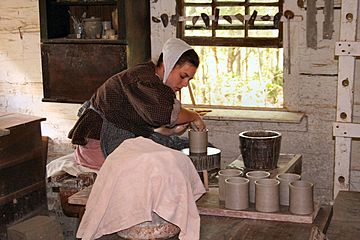
Prairietown is a recreated pioneer village from 1836. It shows what a settlement in early Indiana might have been like. Prairietown has homes, a blacksmith shop, a pottery shop, an inn, a doctor's office, a store, a carpentry shop, and a schoolhouse.
People dressed in old clothes act like the villagers. They show what daily life was like. You can even get a character card at the entrance and pretend to be a person living in Prairietown!
Soaring High: 1859 Balloon Voyage
The 1859 Balloon Voyage opened in 2009. It lets visitors take a 15-minute ride in a giant tethered balloon. The balloon goes up to 377 feet (about 115 meters) high! It's one of the biggest tethered passenger balloons in the world.
There's also an exhibit that teaches you about the history of ballooning. The attraction is based on a real event from 1859. A man named John Wise made the first airmail delivery in the United States by balloon. The balloon ride is open from April to October, but only when the weather is good.
Lenape Indian Camp
The Lenape (Delaware) Indian Camp shows how the Lenape people lived. You can see wigwams made of bark and cattail mats. There's also a fur trade camp with a log cabin. You can learn about Lenape skills like pottery, cooking, gardening, hunting, and beading. Visitors can learn how the Lenape traded with European fur traders. Sometimes, you can even try throwing a tomahawk or making a pendant!
Programs and Special Events
Summer Camps
Conner Prairie offers many different summer camps. These include Adventure Camp, Science Camp, Archaeology Camp, Photography Camp, Maker Camp, and Art Camp. Kids can explore different interests and learn new skills.
Preschool on the Prairie
For younger children, Preschool on the Prairie opened in Fall 2019. It's for kids aged 3–5 and is held in the president's house.
Indianapolis Symphony Orchestra Concerts
Conner Prairie is the summer home for the Indianapolis Symphony Orchestra. They have a concert series called "Symphony on the Prairie." Many people come to enjoy music outdoors. You can bring a blanket and sit on the grass or use tables and chairs.
Follow the North Star Program
For 20 years, Conner Prairie had a program called "Follow the North Star." This experience helped students learn about the Underground Railroad. It won national awards for its educational value. In 2019, Conner Prairie decided to change the program based on feedback. The program was later stopped.
See also


